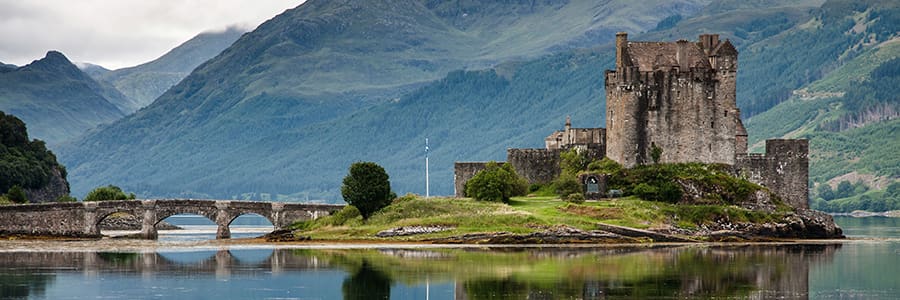
About The Rivers & Lochs of Scotland
No visit to Scotland would be complete without sampling Scotch whisky, or “uisge-beatha na h-Alba,” the water of life.
Scotland has no “great river,” but two main water routes across the country: in the north, the Caledonian Canal connects the Atlantic with the North Sea, while, in the southern Great Glen, four lochs, including the famous Loch Ness, are joined by canals to make one of the greatest waterways of the world.
Whether your heart is called to the Highlands or the stunning Scottish Lowlands, the country’s famous canals, lochs, and rivers offer the chance to witness some of the most dramatic landscapes in the world. In addition to exploring wild glens and mountains, epic battlefields, romantic cities and towns, and magical lochs shrouded in history and legend, you’ll enjoy plenty of chances to savor Scottish delights like fresh-caught salmon and single-malt whisky.
A number of stylish and comfortable canal barges are available for cruising in Scotland, most designed to immerse guests in an authentic Scottish experience, including traditional regional cuisine and furnishings reminiscent of a traditional Scottish country house. Take the high road if you like, but for exploring Scotland, there’s no better way to go than by water!
Rivers & Lochs of Scotland Stats
Length: 137 navigable miles
Depth: Various
Source: Inverness, Scotland on the North Sea
Mouth: Atlantic Ocean near Oban, Scotland
Locks: 29
Countries: Scotland
Learn More About the Waterways of Scotland
Scotland is renowned for its stunning landscapes, including its vast network of navigable waterways. These watercourses, which include rivers, canals, and lochs, have played a vital role in the country’s history, economy, and culture. In this exploration of Scotland’s navigable waterways, we’ll delve into their historical significance, modern-day use, and the natural beauty they showcase.
Historical Significance
The history of Scotland’s navigable waterways can be traced back centuries. The earliest recorded use of water routes for transportation and trade dates to the time of the ancient Celts and Romans. The Romans, in particular, recognized the strategic importance of these waterways and constructed forts and roads along their banks. During the medieval period, the Scottish kings and nobility recognized the potential of water transport for trade and communication. The construction of canals and the improvement of rivers became essential for connecting different regions of the country. One of the most notable early canal projects was the Forth and Clyde Canal, which connected the east and west coasts of Scotland, opening in 1790. The 18th and 19th centuries witnessed a canal-building boom, known as the “Canal Mania.” Canals like the Caledonian Canal, linking the east and west coasts through the Great Glen, and the Union Canal, connecting Edinburgh to Glasgow, played a crucial role in facilitating trade and industrialization. These waterways were the lifeblood of industries such as coal mining, ironworks, and textiles.
Modern Use
While the importance of waterways for industrial transport has diminished, Scotland’s navigable waterways remain vibrant and valuable in the modern era. Today, they serve various purposes, including:
Tourism and Recreation: Scotland’s waterways attract tourists from around the world. The serene beauty of lochs like Loch Ness and Loch Lomond, along with the picturesque canals, offers opportunities for boating, kayaking, fishing, and hiking along scenic towpaths.
Transportation: Although rail and road transport dominate, waterways continue to play a role in moving goods and people. The Forth and Clyde Canal and Union Canal have been revitalized for leisure boating and act as alternative transportation routes in some regions.
Hydroelectric Power: Scotland’s numerous lochs serve as reservoirs for hydroelectric power generation. These facilities harness the energy of flowing water to produce clean electricity.
Conservation: Many waterways in Scotland are home to diverse ecosystems and wildlife. Conservation efforts are ongoing to protect these habitats and promote sustainable practices.
Notable Waterways
Firth of Clyde: This estuary on the west coast of Scotland is a significant waterway for trade and transportation. It is home to several ports, including Glasgow, which was historically a hub for shipbuilding and trade.
Caledonian Canal: Spanning the Great Glen, this canal connects the North Sea with the Atlantic Ocean. Its system of locks and natural lochs is a marvel of engineering and provides a scenic route for boaters.
Loch Ness: Famous for the legend of the Loch Ness Monster, this deep, freshwater loch in the Highlands is the second-largest loch in Scotland by surface area. It is a popular destination for tourists and offers breathtaking views of the surrounding mountains.
Union Canal: Linking Edinburgh to Falkirk, this canal is renowned for the Falkirk Wheel, a rotating boat lift that is an engineering marvel. The canal has been restored for recreational use and is a designated Scottish National Trail.
River Tay: Scotland’s longest river, the Tay flows through the heart of the country and is known for its salmon fishing. It plays a vital role in the agricultural and tourism sectors.
Natural Beauty and Cultural Significance
Scotland’s navigable waterways are not just about utility; they are also repositories of natural beauty and cultural heritage. The rugged landscapes surrounding these watercourses are dotted with historic castles, charming villages, and ancient ruins. These waterways have inspired countless artists, writers, and poets, contributing to Scotland’s rich cultural tapestry.
